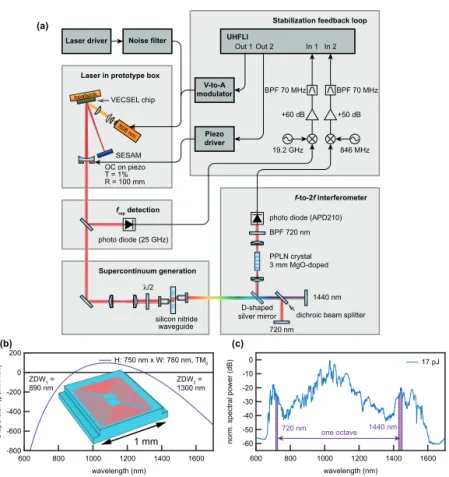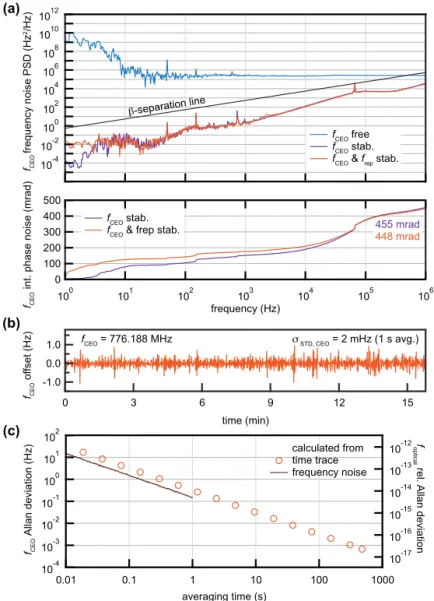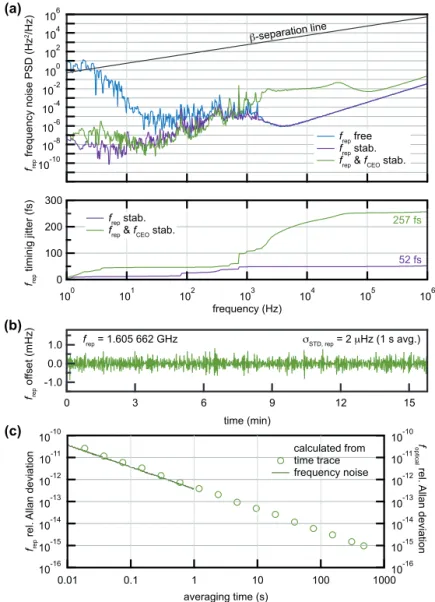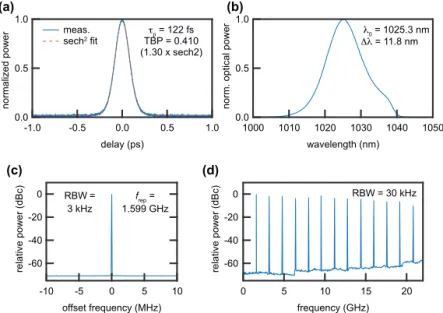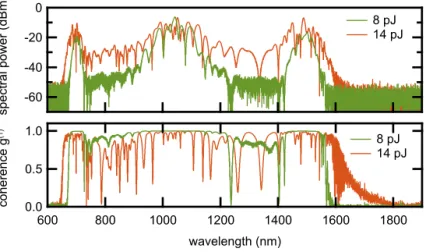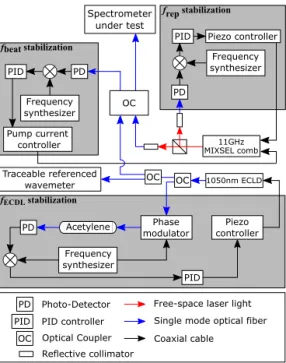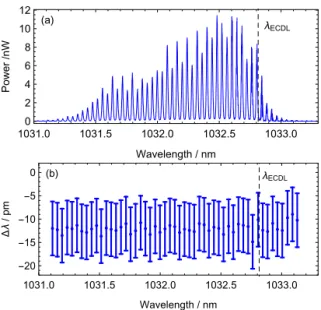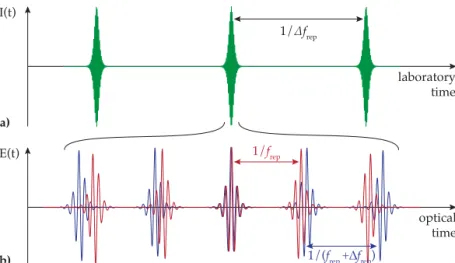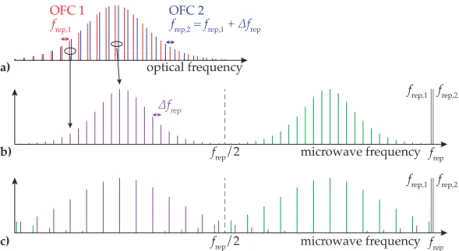Research Collection
Doctoral Thesis
Towards semiconductor disk lasers for single- and dual-comb applications
Author(s):
Nürnberg, Jacob Publication Date:
2021
Permanent Link:
https://doi.org/10.3929/ethz-b-000475198
Rights / License:
In Copyright - Non-Commercial Use Permitted
This page was generated automatically upon download from the ETH Zurich Research Collection. For more information please consult the Terms of use.
ETH Library
Towards semiconductor disk lasers for single- and dual-comb applications
Jacob Nürnberg
Dissertation No. 27300
T owards semiconductor disk lasers for single - and dual - comb
applications
A thesis submitted to attain the degree of DOCTOR of SCIENCES of ETH ZURICH
(Dr. sc. ETH Zurich)
presented by JACOB NÜRNBERG MSc ETH Physics, ETH Zurich,
born on 08.07.1990, citizen of Germany.
Accepted on the recommendation of Prof. Dr. Dr. h. c. Ursula Keller, examiner
Prof. Dr. Oliver Heckl, co-examiner
2021
Contents i
List of figures v
List of tables vii
List of symbols and acronyms ix
Publications xv
Abstract xix
Kurzfassung xxiii
1 Introduction 1
1.1 Semiconductor disk lasers . . . . 2
1.2 The optical frequency comb . . . . 5
1.3 Outline of this thesis . . . . 7
2 Semiconductor based frequency combs 9 2.1 Frequency comb stabilization . . . . 9
2.2 Tightly locked optical frequency comb from a semiconduc- tor disk laser . . . . 12
2.2.1 Introduction . . . . 13
2.2.2 Optical frequency comb (OFC) stabilization . . . . . 14
2.2.3 Methods . . . . 21
2.2.4 Conclusions . . . . 26
2.3 Calibration of high-accuracy spectrometers using stabilized 11-GHz femtosecond semiconductor laser . . . . 30
2.3.1 Introduction . . . . 31
2.3.2 Setup and stabilization . . . . 32
2.3.3 Frequency uncertainty . . . . 34
2.3.4 Results . . . . 35
2.3.5 Conclusion . . . . 37
2.4 Outlook . . . . 40
3 Dual-comb modelocked lasers for applications 41 3.1 Dual-comb spectroscopy . . . . 42
3.2 Dual-comb MIXSEL . . . . 46
3.2.1 Polarization duplexing . . . . 48
3.2.2 Experimental considerations . . . . 49
3.3 Sub-150 fs pulses from an optically pumped broadband modelocked integrated external-cavity surface emitting laser 50 3.4 An unstabilized femtosecond semiconductor laser for dual- comb spectroscopy of acetylene . . . . 62
3.4.1 Introduction . . . . 63
3.4.2 Description of the laser . . . . 65
3.4.3 Laser performance . . . . 67
3.4.4 Spectral aliasing . . . . 67
3.4.5 Fourier transform analysis . . . . 69
3.4.6 Dual-comb spectroscopy . . . . 71
3.4.7 Conclusion and outlook . . . . 74
3.5 Dual-comb distance measurements . . . . 79
3.5.1 Measurement concept . . . . 80
3.5.2 Experimental setup . . . . 81
3.5.3 Time-of-flight results . . . . 84
3.5.4 Vernier effect . . . . 88
3.5.5 Conlusion . . . . 91
3.6 Outlook . . . . 93
4 Submonolayer quantum dots for SDLs 95 4.1 Submonolayer quantum dots . . . . 96
4.2 Temperature resistant fast In
xGa
1-xAs/GaAs quantum dot saturable absorber for the epitaxial integration into semi- conductor surface emitting lasers . . . . 98
4.2.1 Introduction . . . 100
4.2.2 SESAM growth and design . . . 102
4.2.3 Methods . . . 104
4.2.4 Experimental results and discussion . . . 105
4.2.5 Summary . . . 113
4.3 Mode-locking instabilities for high-gain semiconductor disk lasers based on active submonolayer quantum dots . . . 118
4.3.1 VECSEL design, growth, and characterization . . . . 121
4.3.2 Continuous wave (cw) operation . . . 125
4.3.3 Noisy mode-locking operation . . . 127
4.3.4 Simulation . . . 130
4.3.5 Conclusions . . . 134
4.4 Outlook . . . 140
5 Conclusion and outlook 141
Author contributions 145
References 149
Curriculum Vitæ 161
Acknowledgments 163
1.1 Semiconductor lasers . . . . 3
1.2 Pulse train and frequency comb . . . . 6
2.1 Laser and stabilization setup . . . 15
2.2 CEO frequency detection, control, and stabilization . . . 17
2.3 Noise characterization of the CEO frequency . . . 19
2.4 Noise characterization of the repetition rate stabilization . . . 20
2.5 Modelocking characterization of the SDL . . . 21
2.6 Simulation of the generated supercontinuum . . . 23
2.7 11 GHz MIXSEL frequency comb . . . 32
2.8 Beat note behaviour between MIXSEL and ECDL . . . 33
2.9 Histogram of the MIXSEL pulse repetition rate
frep. . . 34
2.10 Experimental setup . . . 35
2.11 OSA spectrum and deviation of the stabilized MIXSEL . . . 36
2.12 FTIR spectrum and deviation of the stabilized MIXSEL . . . 37
3.1 Gas spectroscopy with a frequency comb . . . 42
3.2 Dual-comb spectroscopy in time domain . . . 44
3.3 Dual-comb spectroscopy in frequency domain . . . 45
3.4 Dual-comb MIXSEL and crystal configuration . . . 47
3.5 Thermal imaging of optically pumped VECSEL chips . . . 53
3.6 Layer stack of the semiconductor MIXSEL chip . . . 55
3.7 Linear MIXSEL cavity and dispersion profile . . . 56
3.8 Modelocking diagnostics . . . 58
3.9 Dual-comb MIXSEL laser setup and characterization . . . 66
3.10 Time and frequency domain dual-comb signal . . . 70
3.11 Dual-comb spectroscopy of acetylene . . . 72
3.12 Dual-comb LIDAR concept . . . 81
3.13 Lasers and setup for distance measurements . . . 82
3.14 MIXSEL ranging signal and interferogram . . . 85
3.15 Distance measured with the dual-comb modelocked integrated external- cavity surface-emitting laser (MIXSEL) . . . 87
3.16 Yb:CaF
2dual-comb laser ranging signal and interferogram . . . 89
3.17 Distance measured with the dual-comb Yb:CaF
2laser . . . 89
3.18 Vernier splitting in dual-comb LIDAR . . . 91
4.1 Stranski-Krastanov (SK) and submonolayer (SML) quantum dots (QDs) . 96
4.2 Schematic layer stack of the QD-SESAM structure . . . 102
4.3 Pump probe,
Fsat, and AFM of 3 InGaAs QD-SESAM samples . . . 106
4.4 PL spectra of InGaAs quantum dots . . . 108
4.5 Pump-probe and
Fsatmeasurements with different berillium doping . . 109
4.6 PL measurements of RTA treated samples . . . 110
4.7 Pump-probe and measurement results of two RTA treated SESAMs . . . 112
4.8 SML QD VECSEL design . . . 122
4.9 SML QD VECSEL characterization . . . 124
4.10 Cw performance of the SML QD VECSEL. . . 126
4.11 Ultrafast SML QD VECSEL at low power with unstable modelocking . . 128
4.12 Ultrafast SML QD VECSEL with increasing pump power . . . 129
4.13 Simulation of the modelocking instabilities . . . 131
5.1 Number of dual-comb publications and citations. . . 142
3.1 Parameter sets for distance measurements . . . 84
3.2 Peak finding algorithms . . . 86
4.1 Summary of the MBE growth conditions of the QD-SESAMs . . . 103
4.2 Input parameters for the pulse formation simulation . . . 133
Symbols
α linewidth enhancement factor
α
alinewidth enhancement factor of the absorber α
glinewidth enhancement factor of the gain c speed of light in vacuum (299 792 458 m/s) f
beatbeat note frequency
f
CEOcarrier envelope offset frequency
∆ f
CEOdifference in carrier envelope offset frequency F Fourier transform
f
reppulse repetition rate
∆ f
repdifference in pulse repetition rate F
satsaturation fluence
g gain per unit length k
BBoltzmann constant
λ wavelength
∆λ optical bandwidth expressed as wavelength L
eff.caveffective cavity length
N carrier density n refractive index
∆ν bandwidth expressed as frequency
p pressure
∆R absorber modulation depth
∆R
nsnonsaturable losses
sech
2squared hyperbolic secant
τ
1/e1/e time constant of SESAM recovery τ
fastfast time constant of SESAM recovery τ
slowslow time constant of SESAM recovery T temperature
T
HSheatsink temperature T
reprepetition period
∆T
repdifference in repetition period v
ggroup velocity
V volume
ω
0carrier angular frequency
Acronyms
AC autocorrelation
AFM atomic force microscope AlAs aluminium arsenide AR anti-reflection
ASOPS asynchronous optical sampling BC birefringent crystal
Be Beryllium
BP band pass
BRF birefringent filter
BS beam splitter
CaCO
3calcium carbonate
CARS coherent anti-Stokes Raman spectroscopy CEO carrier envelope offset
CMOS complementary metal-oxide-semiconductor
cw continuous wave
DBR distributed Bragg reflector DCS dual-comb spectroscopy DOS density of states
DPSSL diode pumped solid state laser DUT device under test
ECDL extended cavity diode laser EOM electro-optical modulator FOM figure of merit
FPGA field programmable gate-array FROG frequency resolved optical gating
FS fused silica
FTIR Fourier transform infrared FWHM full width at half maximum
Ga gallium
GaAs gallium arsenide GaSb gallium antimonide GDD group delay dispersion HeNe helium neon laser
HITRAN high-resolution transmission molecular absorption database
HS heatsink
IBS ion beam sputtering
ICL interband cascade laser
In indium
InAs indium arsenide InGaAs indium gallium arsenide
IR infrared
LIDAR light detection and ranging LO local oscillator
LP low pass
MBE molecular beam epitaxy
MIR mid-infrared
MIXSEL modelocked integrated external-cavity surface- emitting laser
ML monolayer
MOVPE metal-organic vapor phase epitaxy MSA microwave spectrum analyzer
OC output coupler
OFC optical frequency comb OSA optical spectrum analyzer PBS polarizing beam splitter
PD photodiode
PECVD plasma enhanced chemical vapor deposition PI proportional-integral
PID proportional-integral-differential
PL photoluminescence
PLL phase-locked loop
PPLN periodically poled lithium niobate PSD power spectral density
QCL quantum cascade laser
QD quantum dot
QW quantum well
RBW resolution bandwidth
RF radio frequency
RIE reactive ion etching ROC radius of curvature RTA rapid thermal annealing
SC supercontinuum
SCG supercontinuum generation SDL semiconductor disk laser
SESAM semiconductor saturable absorber mirror SHG second harmonic generation
Si
3N
4silicon nitride
SiO
2silicon oxide SK Stranski-Krastanov
SML submonolayer
SNR signal-to-noise-ratio SSL solid state laser
SVEA slowly varying envelope approximation Ta
2O
5tantalum pentoxide
TAI international atomic time (from French temps atomique international)
Ti:sapphire titanium-sapphire TOD third order dispersion ToF time-of-flight
TPA two-photon absorption
UHFLI ultra-high frequency digital lock-in amplifier
UV ultraviolet
VBG volume Bragg grating
VCSEL vertical cavity surface-emitting laser
VECSEL vertical external-cavity surface-emitting laser VHG volume holographic grating
WP Wollaston prism
Yb:CaF
2ytterbium doped calcium fluoride
YB:CALGO Yb
3+:CaGdAlO
4Parts of this doctoral thesis are published in the following publications.
Journal papers
[1] C. G. E. Alfieri, D. Waldburger, J. Nürnberg, M. Golling, L. Jau- rigue, K. Lüdge, and U. Keller, «Mode-locking Instabilities for High- Gain Semiconductor Disk Lasers Based on Active Submonolayer Quantum Dots», Phys. Rev. Appl. 10, 44015 (2018).
[2] C. G. E. Alfieri, D. Waldburger, J. Nürnberg, M. Golling, and U.
Keller, «Sub-150-fs pulses from an optically pumped broadband modelocked integrated external-cavity surface emitting laser», Opt.
Lett. 44, 25 (2019).
[3] A. Jallageas, J. Nürnberg, C. G. E. Alfieri, D. Waldburger, S. M.
Link, F. R. M. Emaury, J. Morel, and U. Keller, «Calibration of high-accuracy spectrometers using stabilized 11-GHz femtosecond semiconductor laser», Opt. Express 27, 37552 (2019).
[4] J. Nürnberg, C. G. E. Alfieri, Z. Chen, D. Waldburger, N. Picqué, and U. Keller, «An unstabilized femtosecond semiconductor laser for dual-comb spectroscopy of acetylene», Opt. Express 27, 3190 (2019).
[5] D. Waldburger, A. S. Mayer, C. G. E. Alfieri, J. Nürnberg, A. R.
Johnson, X. Ji, A. Klenner, Y. Okawachi, M. Lipson, A. L. Gaeta, and U. Keller, «Tightly locked optical frequency comb from a semi- conductor disk laser», Opt. Express 27, 1786 (2019).
[6] T. Finke, J. Nürnberg, V. Sichkovskyi, M. Golling, U. Keller, and J. P.
Reithmaier, «Temperature resistant fast In
xGa
1−xAs / GaAs quan-
tum dot saturable absorber for the epitaxial integration into semi-
conductor surface emitting lasers», Opt. Express 28, 20954 (2020).
Conference papers
[1] J. Nürnberg, C. G. E. Alfieri, S. M. Link, D. Waldburger, M. Golling, and U. Keller, «Femtosecond dual-comb MIXSEL at 1030 nm», in SPIE Photonics West - LASE, talk - best student paper award (2018).
[2] C. G. E. Alfieri, D. Waldburger, J. Nürnberg, M. Golling, and U.
Keller, «Sub-300-fs semiconductor disk laser based on active quan- tum dots», in SPIE Photonics West - LASE, invited talk (2018).
[3] C. G. E. Alfieri, D. Waldburger, J. Nürnberg, M. Golling, and U.
Keller, «Ultrafast Quantum Dot VECSELs: Record Performance Depending on Growth Techniques», in Conference on Lasers and Electro-Optics (CLEO), talk (2018), SF1G.2.
[4] A. Jallageas, J. Nürnberg, C. G. E. Alfieri, D. Waldburger, S. M.
Link, F. R. M. Emaury, J. Morel, and U. Keller, «Wavelength cali- bration of high-performance spectrometers with a stabilized opti- cal comb from an ultrafast semiconductor disk laser», in Confer- ence on Lasers and Electro-Optics (CLEO), talk (2018), ATh3O.6.
[5] J. Nürnberg, C. G. E. Alfieri, D. Waldburger, M. Golling, N. Picqué, and U. Keller, «Free-running, Femtosecond Dual-Comb MIXSEL for Spectroscopy of Acetylene», in Conference on Lasers and Electro- Optics (CLEO), poster (2018), JW2A.157.
[6] D. Waldburger, A. S. Mayer, C. G. E. Alfieri, J. Nürnberg, A. R.
Johnson, X. Ji, A. Klenner, Y. Okawachi, M. Lipson, A. L. Gaeta, U. Keller, A. L. Gaeta, and U. Keller, «Fully Stabilized Optical Fre- quency Comb from a Semiconductor Disk Laser», in Conference on Lasers and Electro-Optics (CLEO), upgraded to invited talk (2018), SM4L.7.
[7] C. G. E. Alfieri, D. Waldburger, J. Nürnberg, M. Golling, and U.
Keller, «Quantum Dot Semiconductor Disk Lasers: Record Perfor- mance Depending on Growth Techniques», in Advanced Photonics Congress (APC), talk (2018), NoM2D.3.
[8] J. Nürnberg, C. G. E. Alfieri, Z. Chen, D. Waldburger, M. Golling, N. Picqué, and U. Keller, «Dual-Comb Spectroscopy with one un- stabilized semiconductor laser», in Advanced Photonics Congress (APC), invited talk (2018), p. IM3I.1.
[9] J. Nürnberg, C. G. E. Alfieri, D. Waldburger, M. Golling, and U.
Keller, «Pushing integrated semiconductor disk lasers towards 100- fs pulses», in Advanced Photonics Congress (APC), talk (2018), JW2I.4.
[10] D. Waldburger, A. S. Mayer, C. G. E. Alfieri, J. Nürnberg, A. R.
Johnson, X. Ji, A. Klenner, Y. Okawachi, M. Lipson, A. L. Gaeta,
U. Keller, A. L. Gaeta, and U. Keller, «Silicon nitride waveguide
enables self-referenced frequency comb from a semiconductor disk
laser», in Advanced Photonics Congress (APC), talk (2018), JW3I.7.
- LASE, edited by U. Keller, invited talk (2019), pp. 10901–19.
[12] J. Nürnberg, C. G. E. Alfieri, D. Waldburger, L. M. Krüger, M.
Golling, and U. Keller, «Light detection and ranging with a sin- gle free-running dual- comb semiconductor disk laser», in SPIE Photonics West - LASE, talk - best student paper award (2019), pp. 10901–24.
[13] J. Nürnberg, C. G. E. Alfieri, Z. Chen, D. Waldburger, M. Golling, N. Picqué, and U. Keller, «Dual-Comb Spectroscopy of acetylene gas with one unstabilized semiconductor laser», in SPIE Photonics West - LASE, invited talk (2019), pp. 10904–7.
[14] J. Nürnberg, C. G. E. Alfieri, Z. Chen, D. Waldburger, M. Golling, N. Picque, and U. Keller, «Dual-Comb Spectroscopy of Acetylene with a Single, Free-Running MIXSEL Generating two Frequency Combs», in European Conference on Lasers and Electro-Optics Eu- rope (CLEO/Europe-EQEC), talk (2019), pp. 1–1.
[15] J. Nürnberg, C. G. E. Alfieri, D. Waldburger, L. Kruger, M. Golling,
and U. Keller, «A Single Free-Running Dual-Comb MIXSEL for
Fast and Precise Distance Measurements», in European Conference
on Lasers and Electro-Optics Europe (CLEO/Europe-EQEC), talk
(2019), pp. 1–1.
The optical spectrum associated with the pulse train of an ultrafast laser consists of a multitude of equidistantly spaced frequencies. In analogy to the length markings of a ruler, the lines of the so-called optical fre- quency comb (OFC) can be utilized for frequency metrology. With a rela- tive uncertainty down to 10
−19OFCs present an unprecedented accuracy.
Their applications range from wavelength calibration in astronomy over extremely precise timing and clock distribution to fiberoptic communi- cation. The multiheterodyne beat note of two combs with slightly dif- ferent line spacing enables fast and precise molecular spectroscopy. The widespread use of frequency combs creates the demand for new, compact, simple, and cost efficient ultrafast laser sources.
Semiconductor laser technology has revolutionized modern technol- ogy and can nowadays be found in smartphones and fiber communica- tion in virtually every household. Miniaturization and mass scalability have enhanced their economical impact since their first demonstration in 1962. The vertical external-cavity surface-emitting laser (VECSEL) com- bines the advantages of semiconductor lasers with a thin gain geometry and a macroscopic cavity. With efficient heat removal and mode area scal- ing, more than 100 W of average power have been achieved in continuous wave (cw) operation. The external cavity enables passive modelocking with a semiconductor saturable absorber mirror (SESAM) for ultrashort pulse generation. In recent years, pulse durations below 100 fs with op- tical spectra spanning more than 17 nm have been achieved. The mode- locked integrated external-cavity surface-emitting laser (MIXSEL) unites VECSEL and SESAM in a single epitaxial structure. Its straight cavity presents the simplest laser geometry for ultrashort pulse and frequency comb generation. Short carrier lifetimes and a high gain crosssection effi- ciently suppress Q-switching instabilities in VECSEL and MIXSEL, a com- mon challenge for high repetition rate solid state lasers. Very short cavities with pulse repetition rates up to 100 GHz have been demonstrated.
VECSEL and MIXSEL, also referred to as semiconductor disk lasers
(SDLs), are very promising laser sources for frequency comb applications.
The cavity geometry yields excellent brightness and beam quality while being compact in size and cost efficient due to mass scalability in produc- tion. Semiconductor band gap engineering increases their versatility with the ability to tailor the emission wavelength to the specific application.
The work presented in this dissertation demonstrates semiconductor disk lasers for single and dual-comb applications.
With most applications relying on the precise knowledge of the ex- act frequency, the stabilization of the OFC becomes essential for reliable metrology. For the first time, we demonstrate a fully stabilized self- referenced frequency comb of a VECSEL without external amplification or compression. Customized silicon nitride (Si
3N
4) waveguides enable ef- ficient supercontinuum generation for carrier envelope offset (CEO) detec- tion even with low pulse energies. Until the efficiency of the waveguides and the pulse energy of the MIXSEL further increase, external referencing remains the preferred method for a fully stable MIXSEL comb. We cali- brate the wavelength axis of wavemeters with a MIXSEL comb referenced to a Doppler broadened absorption line of acetylene.
The dual-comb MIXSEL utilizes a birefringent crystal for intracavity polarization duplexing and emits two collinear but orthogonally polar- ized frequency combs. A different path length inside the birefringent crystal results in a slight difference in the line spacing of the two combs.
The shared cavity intrinsically yields a high mutual coherence, making the compact dual-comb MIXSEL the ideal source for dual-comb applica- tions. With a new semiconductor structure, we achieve pulses as short as 139 fs in single comb operation, world record for the MIXSEL. With the same chip, we construct the first femtosecond dual-comb MIXSEL with a spectral bandwidth of 3 nm. The optical spectrum is 10 times broader compared to the first dual-comb MIXSEL. We successfully demonstrate dual-comb spectroscopy of acetylene with the unstabilized laser. The in- terrogated absorption lines yield excellent agreement with the HITRAN absorption database. Dual-comb distance measurements with fast update rates and micrometer resolution are performed without any modification to the laser and compared to a diode pumped dual-comb ytterbium doped calcium fluoride (Yb:CaF
2) laser.
The high level of integration of the MIXSEL demands for a well matched epitaxial growth of gain and absorber. Quantum dots (QDs) fea- ture a reduced temperature dependent wavelength shift and additional ge- ometric degrees of freedom and present a viable alternative to established quantum wells (QWs). With the submonolayer (SML) growth technique, particular high dot densities for high gain and absorption can be achieved.
In an iterative process we develop SML quantum dot based SESAMs that
achieve recovery times on the order of magnitude of state-of-the-art QW
SESAMs. In gain, we discover that SML QDs cause significant modelock-
ing instabilities. However, the high gain allowed us to achieve more than
11 W in cw operation.
and is followed by the next technological advancements. Our research
group works on transferring the SDL dual-comb technology from the well
established 1 µm regime to the molecular fingerprint region between 3 µm
to 5 µm. The development of application grade dual-comb sources en-
courages simultaneous research efforts on dual-comb solid state lasers.
Das optische Spektrum des Pulszuges eines ultraschnellen Lasers besteht aus einer Vielzahl einzelner Frequenzen mit regelmässigem Abstand. Ver- gleichbar mit einem Lineal lassen sich die Linien des sogenannten op- tischen Frequenzkamms für präzise Frequenzmessungen einsetzen. Mit einer relativen Messunsicherheit von bis zu 10
−19zeigen Frequenzkämme eine bisher nie dagewesene Genauigkeit. Anwendungen reichen von der Wellenlängenkalibration für die Astronomie über extrem präzise Zeitmes- sungen und Zeittaktverteilung bis hin zu faseroptischer Kommunikation.
Mit den Überlagerungsfrequenzen zweier Frequenzkämme lassen sich un- vergleichbar schnelle und genau Molekularspektrometer realisieren. Für die weitreichende Anwendung dieser Techniken werden allerdings neue, kompakte, einfache und kosteneffiziente ultraschnelle Laserquellen benö- tigt.
Halbleiterlasertechnik hat die moderne Technologie revolutioniert und ist heutzutage allgegenwertig in Smartphones und Faserkommunikation.
Allen voran die Miniaturisierung und die Möglichkeit der günstigen Mas-
senproduktion beförderten ihre Wirtschaftlichkeit seit der ersten Halblei-
terdiode 1962. Der VECSEL – vertical external-cavity surface-emitting laser
– bringt die Vorteile der Halbleiterlasertechnologie mit effizienten Kühl-
möglichkeiten einer dünnen Scheibengeometrie und einer externen La-
serkavität zusammen. Durch Skalierung der Größe der Lasermode konn-
ten über 100 W im Dauerstrichbetrieb (cw) erreicht werden. Die externe
Kavität erlaubt ausserdem die Kombination mit einem saturierbaren Ab-
sorbierspiegel (SESAM) um über Modenkopplung extrem kurze Pulse zu
erzeugen. Vor wenigen Jahren wurden Pulse kürzer als 100 fs mit über
17 nm optischer Bandbreite erzeugt. Die Weiterentwicklung des VECSEL,
der MIXSEL – modelocked integrated external-cavity surface-emitting laser –
vereint saturierbaren Absorber und Lasermedium in einer einzigen Halb-
leiterstruktur. Die gerade, lineare Kavität des MIXSEL stellt die einfachste
Lasergeometrie dar, mit der ultraschnelle Laserpulse und optische Fre-
quenzkämme erzeugt werden können. Kurze Lebensdauern des ange-
regten Laserzustands und einer hoher Verstärkungswirkungsquerschnitt
verhindern effizient Laserinstabilitäten aufgrund von Güteschaltung in der Kavität, eine häufige Herausforderung für Festkörperlaser mit hohen Pulsrepetitionsraten. Mit sehr kurzen Kavitäten konnten Pulsfrequenzen von bis zu 100 GHz gezeigt werden.
VECSEL und MIXSEL, die gemeinsam auch Halbleiterscheibenlaser genannt werden, sind äußerst vielversprechende Laserquellen für Fre- quenzkammanwendungen. Sie erreichen eine exzellente Helligkeit und ein hervorragendes Strahlprofil, sind kompakt und aufgrund der Skalier- barkeit der Halbleiterproduktion sehr kosteneffizient. Über die Bandlücke im Halbleiter lässt sich die Emissionswellenlänge für jede Anwendung genau einstellen. Die Arbeiten in dieser Dissertation zeigen den Weg zur Anwendung optischer Frequenzkämme von Halbleiterscheibenlasern.
Da die meisten Anwendungen auf der genauen Kenntnis der exakten Frequenz beruhen, ist die Stabilisierung von Frequenzekämmen von es- sentieller Bedeutung in der Metrologie. Wir präsentieren hier den ersten voll stabilisierten, selbst-referenzierten Frequenzkamm eines VECSEL, oh- ne dass externe Pulsverstärkung oder -kompression zum Einsatz kommt.
Spezielle Wellenleitern aus Siliziumnitrid (Si
3N
4) erlauben uns selbst mit geringen Pulsenergien effizient ein Superkontinuum zu erzeugen und die Träger-Einhüllende-Phase zu messen. Bis diese Technologie für den MIX- SEL zur Verfügung steht bleibt die externe Referenzierung die bevorzugte Methode auch hier einen stabilen Frequenzkamm zu erreichen. Über die Referenzierung gegen eine Doppler verbreiterte Absorptionslinie von Ace- tylen können wir mit einem MIXSEL erfolgreich die Wellenlänge optischer Spektrometer kalibrieren.
Mit Hilfe eines doppelbrechenden Kristalls emittiert der Doppelkamm- MIXSEL zwei kollineare Frequenzkämme in orthogonaler Polarisation.
Aufgrund eines kleinen Gangunterschieds im Kristall haben die Frequenz- kämme einen leicht verschiedenen Linienabstand. Die geteilte optische Kavität führt zu einer intrinsisch hohen gemeinsamen Stabilität der beiden Kämme und macht den Doppelkamm-MIXSEL zur idealen Laserquelle für Doppelkammanwendungen. Mit einer neuen Halbleiterstruktur erreichen wir Pulsdauern von nur 139 fs, Rekord für den MIXSEL. Dieselbe Struktur erlaubt es uns den ersten Femtosekunden-Doppelkamm-MIXSEL mit 3 nm optischer Bandbreite zu konstruieren. Insbesondere ist das optische Spek- trum zehn mal breiter als das des ersten Doppelkamm-MIXSELs. Ohne weitere Stabilisierung können wir Acetylen mithilfe von Doppelkamm- spektroskopie detektieren und erreichen dabei eine sehr gute Überein- stimmung mit der HITRAN Datenbank. Ohne den Laser zu modifizieren führen wir auch erfolgreich Distanzmessungen mit Genauigkeiten im Mi- krometerbereich durch und vergleichen diese mit einem diodengepump- ten Doppelkamm-Yb:CaF
2Laser.
Der hohe Grad der Integration im MIXSEL verlangt nach passen-
dem Lasermedium und Absorber in der Halbleiterstruktur. Quantenpunk-
te stellen dabei aufgrund einer geringeren Temperaturabhängigkeit der
(SML) Wachstumstechnik erreicht dabei besonders hohe Punktdichten, die sich durch eine große Verstärkung bzw. Absorption äußern. In einem iterativen Prozess entwickeln wir saturierbare Absorbierspiegel auf Ba- sis von SML Quantenpunkten, deren Erholungszeit an die von modernen Quantentopf-SESAMs heran reicht. Bei der Integration als Verstärkungs- medium zeigen sich aber starke Instabilitäten während der Modenkopp- lung. Andererseits erlaubt uns der hohe Verstärkungsquerschnitt über 11 W im Dauerstrichbetrieb zu erreichen.
Unsere Forschung stellt ein Kapitel der Evolution von Halbleiterschei-
benlasern zu kompakten Lichtquellen für Frequenzkammapplikationen
dar. Unsere Arbeitsgruppe erforscht die Möglichkeit die Doppelkamm-
MIXSEL Technologie in den für molekulare Absorptionsspektrosko-
pie besonders interessanten Mittelwellenlängenbereich zwischen 3 und
5 µm zu transferieren. Für die weitere Entwicklung anwendungsori-
entierter Doppelkamm-Laserquellen werden ebenfalls Doppelkamm-
Festkörperlaser erforscht.
Introduction
After Theodore H. "Ted" Maiman demonstrated stimulated emission of radiation for the first time in 1960 [1], the laser was sometimes described as a solution looking for a problem [2]. Unforeseen was the technological revolution that followed. Nowadays, we unlock smartphones, control self driving cars, and connect to the internet with the help of lasers. In indus- try, lasers are used for cutting, welding, drilling, and texturing materials with the power of light. Scientists employ lasers to measure the distance to the moon [3], communicate with satellites, build microscopes [4], detect trace gases [5], and even gravitational waves [6]. Lasers have become so abundant in daily life, science, and technology that the acronym LASER – short for Light Amplification by Stimulated Emission of Radiation – has quickly been replaced by the word laser that is now listed in dictionaries across the world.
Characteristic for lasers is the emission of a highly directional, coherent beam of light. Emission at constant output power and ideally contained in a single longitudinal mode, i.e. a single optical frequency, is referred to as continuous wave (cw) operation. In modelocked operation, the phase relation between a range of longitudinal modes supported by the laser cavity is locked. These ultrafast lasers emit a train of equidistant, short, and intense pulses of light with pulse durations as short as few pico- (1 ps
= 10
−12s) or even femtoseconds (1 fs = 10
−15s). Ultrafast lasers further
diversified the portfolio of laser applications: nonlinear microscopy chal-
lenges the diffraction limit [7] and the generation of attosecond (1 as =
10
−18s) pulses allows the direct study of molecular processes [8], naming just two examples here.
1.1 Semiconductor disk lasers
The year 1962 marks the advent of semiconductor laser technology with the first demonstration of emission of coherent light from a gallium ar- senide junction, the first laser diode [9]. Not one year later, Herbert Kroe- mer proposed the concept for a double heterodyne semiconductor struc- ture, a quantum well (QW), as the basis for the first semiconductor laser operated at room temperature [10]. Semiconductor lasers benefit from the scalability, miniaturization, and high level of integration of the semicon- ductor technology as well as the wavelength versatility through band gap engineering. It is not surprising that the first lasers found in virtually every household were semiconductor lasers in CD- and DVD-players.
Edge emitter These very first commercial semiconductor lasers were electrically pumped edge emitting structures as shown in Fig. 1.1a. A small footprint and wafer scale manufacturing contributed to a lasting popularity of edge emitters. High power operation can be achieved by stacking several diodes, although the individual laser is limited in output power. However, the strongly diverging emission prevents the usage of edge emitters in applications that require good beam quality.
VCSEL The efforts to improve the beam quality of semiconductor disk
lasers cumulated in the demonstration of the first vertical cavity surface-
emitting laser (VCSEL) in 1979 [11]. These devices employ an electrically
pumped active region in a monolithic Fabry-Perot cavity with a partial
top reflector (Fig. 1.1b). The Fabry-Perot resonator is formed by two dis-
tributed Bragg reflectors (DBRs) and, in contrast to edge emitters, the
cavity is oriented vertical towards the semiconductor plane. VCSELs find
their application in optical communication technology and have recently
been adopted for use in smartphones [12]. However, the limited output
power of only a few milliwatts per device renders them insufficient for
high brightness applications.
V
edge-emitter
V
VCSEL
pump OC
VECSEL
pump OC
SESAM VECSEL
pump OC
MIXSEL
continuous wave
modelocked operation
(d)
(b)
(a) (c)
(e)
Figure 1.1: The classes of cw and modelocked semiconductor lasers. (a) Edge emitter.
(b) Electrically pumped vertical cavity surface-emitting laser (VCSEL). (c) Vertical external- cavity surface-emitting laser (VECSEL). (d) Modelocked VECSEL with semiconductor saturable absorber mirror (SESAM). (e) Modelocked integrated external-cavity surface-emitting laser (MIXSEL). OC: output coupler. Adapted with permission from [13].
VECSEL Additional degrees of freedom for the laser cavity are accessed with an external cavity. In vertical external-cavity surface-emitting lasers (VECSELs), the top reflector of a VCSEL is replaced by an external out- put coupler (OC) (Fig. 1.1c). The first electrically pumped VECSEL was demonstrated in 1993 [14], but significant power scaling was only achieved after adopting an optical pumping scheme [15].
To date, cw-VECSELs have been demonstrated with output powers up to 106 W in multimode operation and find their use in medical applica- tions or ion traps for quantum computing. In 2017, Mircea Guina et al.
published a comprehensive overview of the cw-VECSEL platform [16].
When combined with a semiconductor saturable absorber mirror
(SESAM), the VECSEL can be modelocked for ultrafast pulse genera-
tion (Fig. 1.1d). Fundamental modelocking is commonly achieved with
gigahertz repetition rates. Short carrier lifetimes and a large gain cross sec-
tion in the semiconductor efficiently prevent Q-switching instabilities [17, 18] that render the development of solid state lasers (SSLs) in this regime difficult [19, 20].
Since the first demonstration of a modelocked VECSEL in 2000 [21], pulse durations below 100 fs have been achieved [22, 23] and peak powers up to 6.3 kW have been reported [24]. Ursula Keller and others present a comprehensive overview of the ultrafast VECSEL platform in several review articles [25–28].
MIXSEL A particularly compelling approach monolithically integrates the saturable absorber into the gain structure which is possible as both rely on the same semiconductor platform and materials. The resulting mod- elocked integrated external-cavity surface-emitting laser (MIXSEL) has a simple, straight, external cavity, with the only other cavity element re- quired for ultrafast operation being the output coupler (Fig. 1.1e) [29, 30]. This simple approach enabled pulse repetition rate scaling up to 100 GHz [31]. With up to 6.4 W of output power [32] and pulse dura- tions as short as 139 fs [33], the MIXSEL approaches performance levels of ultrafast modelocked VECSELs. The straight, unfolded, external cav- ity further enabled polarization duplexing by insertion of a birefringent crystal [34]. The dual-comb MIXSEL emits two orthogonally polarized pulse trains with slightly different pulse repetition rates. The two mode- locked lasers from the same cavity experience high mutual coherence that can be exploited for frequency comb spectroscopy and light detection and ranging (LIDAR) as discussed in chapter 3.
The external cavity VECSEL and MIXSEL are also referred to as semi-
conductor disk lasers (SDLs) and unite the key advantages of semiconduc-
tor lasers with the ones of thin disk lasers. The thin gain geometry results
in a quasi-one dimensional heat-flow and allows for efficient cooling. The
high-Q external cavity enables low noise performance and perfect beam
quality in the fundamental transverse electromagnetic mode (TEM
00). Ad-
ditional modes of operation like intracavity frequency doubling, wave-
length tuning or polarization duplexing are possible and power scaling is
achieved by increasing the mode area on the semiconductor chip. Finally,
semiconductor band gap engineering enables design of wavelengths and
bandwidth to the specific application. To date, SDL technology covers a spectral range from the ultraviolet (UV) to the infrared (IR) [16].
The ultrafast SESAM modelocked VECSEL awaits its widespread com- mercial adaptation as this technology is still subject to ongoing research.
Their use in multiphoton microscopy has been shown in in 2017 [35] and, as part of this thesis, we calibrate the wavelength scale high performance wavemeters with the help of a MIXSEL optical frequency comb (OFC) [36].
1.2 The optical frequency comb
The electric field of a laser pulse is composed of a temporal envelope A ( t ) (usually a Gaussian or hyperbolic secant) wrapped around an oscillation with carrier frequency ω
0E ( t ) = A ( t ) · e
iω0t.
Here, we adopted the complex notation for electromagnetic waves and omit the spatial component. In a train of pulses of a modelocked laser, the signal reoccurs after a round trip time T
rep(Fig. 1.2a). The mathematical expression is a superposition of delayed pulses or a convolution with a sequence of delta functions
E ( t ) = ∑
n
A ( t − nT
rep) e
iω0(t−nTrep)· e
i2πfCEOnTrep= A ( t ) e
iω0t∗ ∑
n
δ ( t − nT
rep) e
i2πfCEOt.
The last term describes the pulse-to-pulse carrier envelope offset (CEO) phase shift between envelope A ( t ) and carrier wave expressed as the fre- quency f
CEO. The Fourier transform F yields optical spectrum associated with this train of pulses
F[ E ( t )] = E ˜ ( ω )
= A ˜ ( ω − ω
0) ∑
n
δ ω − 2π ( n f
rep+ f
CEO) . (1.1) Here, ˜ A ( ω ) = F [ A ( t )] describes the Fourier transform of the pulse en- velope and the pulse repetition rate f
rep= 1/T
rephas been introduced.
Equation (1.1) describes a sequence of equidistant frequencies spaced by
|E(t)| E(t)
time
T
rep= f
rep-1I(f)
frequency
a) b)
n�ϕ
CEOf
CEOf
repFigure 1.2: (a) A train of laser pulses in time is linked to (b) optical frequency comb (OFC) of equidistantly space modes in frequency domain via the Fourier transform F. The line separation is the inverse of the time between two pulses in time frep=1/Trep. The additional offset corresponds to a pulse to pulse CEO phase shift.
f
repwith an offset from zero corresponding to f
CEO, the optical frequency comb (OFC) (Fig. 1.2b). Once these two frequencies are well known, the position of every comb line is well defined as
f
n= n f
rep+ f
CEO. (1.2)
A fully stabilized frequency comb may serve as an extremely precise calibration for unknown optical frequencies (i.e. at hundreds of terahertz), similar to a ruler in space. The beat note f
beatof the unknown optical sig- nal with the closest comb line corresponds to their difference in frequency.
It presents an efficient down-conversion from the optical terahertz domain to the electronically accessible megahertz range. With repetition rates up to the low gigahertz range, affordable commercial electronics suffice to precisely calibrate the unknown frequency.
Frequency combs started a revolution in time and frequency metrology
since their introduction in the late 1990s. An OFC can provide a long term
calibration in large scale astronomical spectrographs [37], high repetition
rate combs provide ultra-broadband, coherent communication [37], and
control over the CEO has become key to attosecond science [38]. In recent
years, two combs with slightly different line spacing, similar to Vernier
callipers, have been used for precise spectroscopy [39, 40] and fast distance
measurements [41]. The OFC as a novel tool in science and technology was
recognized with the Nobel prize in 2005 [42].
1.3 Outline of this thesis
The goal of this thesis is the development of compact SDL based OFCs for application. The focus lies in the proof-of-principle demonstration of SDL frequency comb application. This includes performance scaling, stabilization, and further development of SDLs to enable new applications.
Chapter 2, discusses single OFCs from VECSEL and MIXSEL. In sec- tion 2.2 we demonstrate the full self-referenced stabilization of a semicon- ductor frequency comb without external compression or amplification.
This result was achieved by combining the development of a sub 100 fs ultrafast VECSEL reaching 1 kW peak power with efficient supercontin- uum generation (SCG) even with low pulse energies in customized silicon nitride (Si
3N
4) waveguides provided by the groups of Prof. Alexander L. Gaeta and Prof. Michal Lipson from Columbia university. In section 2.3, we collaborate with the Eidgenössisches Institut für Metrologie (METAS) to employ a 11 GHz MIXSEL OFC for the calibration of the wavelength scale of high performance spectrometers. For this purpose, the repetition rate f
repof OFC is actively stabilized to a synthesized microwave frequency.
The carrier envelope offset f
CEOstabilized by locking the beat note of a single comb line to a single frequency fiber laser referenced to a Doppler broadened absorption line of acetylene.
Chapter 3 presents the newest developments on dual-comb MIXSELs:
After introducing the dual-comb principle, we present the development path to a MIXSEL emitting pulses as short as ∆λ = 139 fs in section 3.3.
The resulting optical spectrum spans up to 13 nm at λ = 1030 nm. With this new gain chip and an adapted cavity configuration compared to the first result [43] we broaden the OFCs of the dual-comb system to ≈ 3 nm while adjusting the center wavelength. In section 3.4 we use the free- running unstabilized dual-comb MIXSEL for dual-comb spectroscopy on the 3ν
3absorption band of acetylene. Afterwards, we employ the same laser for time-of-flight (ToF) distance measurements and compare the per- formance to an in house developed dual-comb SSL laser.
Submonolayer (SML) quantum dots (QDs), as potential gain and ab-
sorber for ultrafast SDLs form the core of chapter 4. An iterative im-
provement process that yields well performing SML QDs for the absorbers
SESAMs is presented in section 4.2. In section 4.3, we show that similar quantum dots are unsuitable for modelocked SDLs. In cw-operation how- ever, more then 11 W can be achieved. Wavelength filtering and tuning is realized with a birefringent filter.
The main results of chapters 2 to 4 are presented in journal publications. Text
and figures are presented as published. The format of the text, the numbering and
size of figures and tables were adapted to match the style of this thesis. All papers
are reprinted with permission. The copyright of the original publications are held
by the respective copyright holders.
Semiconductor based frequency combs
From the brief introduction of the OFC in section 1.2 we have seen that the position of each comb line f
nis well defined, if the two degrees of freedom f
CEOand f
repare well known and precisely controlled. However, both of these frequencies are subject to noise that affects the OFC. According to eq. (1.2), instabilities on f
CEOintroduce a linear shift of all comb lines together while the line spacing underlies variations in f
rep.
2.1 Frequency comb stabilization
Many applications require locking of both of these degrees of freedom to yield comb lines with adequate accuracy. The pulse repetition rate cor- responds to the intracavity pulse round trip time f
rep= 1/T
repand is directly detectable with sufficiently fast photodetectors. An error signal is generated by comparing the instantaneous pulse repetition rate to a refer- ence local oscillator. A feedback loop finally adjusts the pulse repetition rate by tuning the cavity length in order to minimize the deviation from the stable reference. In modelocked SDLs, this can be achieved with a piezo mounted cavity output coupler or SESAM, as presented in [44, 45].
Detection and stabilization of the carrier envelope offset is more chal-
lenging, as f
CEOdoes not contain any optical power but is the zero point
extrapolation of the frequency comb in the terahertz range. Of several
techniques presented in the late 1990s for direct detection of f
CEO[46–48],
f -to-2 f became the most common approach. In this approach, light from
the long wavelength part of the spectrum is frequency doubled via sec- ond harmonic generation (SHG). Recombining the frequency double part in space and time with the corresponding short wavelength region of the spectrum generates a heterodyne beat note signal that contains f
CEO.The optical beat note is then detected with a suitable photodetector for stabi- lization.
The f -to-2 f technique requires a coherent octave spanning laser spec- trum, also referred to as a supercontinuum. Most laser sources do not satisfy this criterion directly from the oscillator. Instead the output of the laser is spectrally broadened in a nonlinear medium or device. Supercon- tinuum generation (SCG) in bulk glass was first presented in 1970 [49].
Since then, many techniques have been developed, but due to the low pulse energies of SDL, SCG and CEO detection relied on external ampli- fication and compression [50, 51]. In recent years, SCG with low power pulses from SSLs has been demonstrated in Si
3N
4waveguides [52–54]. In the following paper, we adopted the next generation of waveguides for the CEO detection and frequency comb stabilization of a VECSEL without external amplification or compression.
In other cases, it may not be possible to generate a supercontinuum
from the laser. In the paper presented in section 2.3, we stabilize a single
comb line against a Doppler broadened absorption line of acetylene. With
a tight lock on the pulse repetition rate, the resulting comb is sufficiently
stabilized to reliably calibrate the frequency axis on high performance
spectrometers.
2.2 Tightly locked optical frequency comb from a semi- conductor disk laser
Authors: Dominik Waldburger (project lead; design, growth, and fabrication of the SDL; experimental stabilization) Aline S. Mayer (support of lab work and stabilization) Cesare G. E. Alfieri (support of the SDL development and growth, experimental lab work and stabilization) Jacob Nürnberg (support of the SDL development and growth, experimental lab work and stabilization) Andrea R. Johnson(development, design, and fabrication of the silicon nitride waveguide)
Xingchen Ji (development, design, and fabrication of the silicon nitride waveguide)
Alexander Klenner (development, design, and fabrication of the silicon nitride waveguide) Yoshitomo Okawachi (development, design, and fabrication of the silicon nitride waveguide) Michal Lipson (supervision)
Alexander L. Gaeta (supervision) Ursula Keller (supervision) Journal: Optics Express
doi: 10.1364/OE.27.001786 Published 22 January 2019.
©2019 Optical Society of America. One print or electronic copy may be made for personal use only. Systematic reproduction and distribution, duplication of any material in this paper for a fee or for commercial purposes, or modifications of the content of this paper are prohibited.
Full citation to this paper:
D. Waldburger, A. S. Mayer, C. G. E. Alfieri, J. Nürnberg, A. R. Johnson, X. Ji, A. Klenner, Y. Okawachi, M. Lipson, A. L. Gaeta, and U. Keller,
«Tightly locked optical frequency comb from a semiconductor disk laser»,
Opt. Express 27, 1786 (2019)
Tightly locked optical frequency comb from a semiconduc- tor disk laser
Dominik Waldburger
1,*, Cesare G. E. Alfieri
1, Aline S. Mayer
1, J. Nürnberg
1, Andrea R. Johnson
2, Xingchen Ji
3, Alexander Klenner
2,
Yoshitomo Okawachi
2, Michal Lipson
3, Alexander L. Gaeta
2, and Ursula Keller
11
Department of Physics, Institute for Quantum Electronics, ETH Zurich, Auguste- Piccard-Hof 1, 8093 Zürich, Switzerland
2
Department of Applied Physics and Applied Mathematics, Columbia University, New York, New York 10027, USA
3
Department of Electrical Engineering, Columbia University, New York, New York 10027, USA
*
dominikw@phys.ethz.ch
Ultrafast semiconductor disk lasers (SDLs) passively modelocked using semi- conductor saturable absorber mirrors (SESAMs) generate optical frequency combs (OFCs) with gigahertz line spacings - a regime where solid-state and fiber lasers struggle with geometrical and Q-switching limitations. We stabilized both the frequency comb spacing and the offset without any additional external opti- cal amplification or pulse compression. The overall noise performance is compet- itive with other gigahertz OFCs. A SESAM-modelocked vertical external-cavity surface-emitting laser (VECSEL) at a center wavelength around 1 µm generates 122 fs pulses with 160 mW average output power and we only needed 17 pJ pulse energy coupled into a silicon nitride (Si
3N
4) waveguide for supercontinuum gen- eration (SCG) and OFC offset stabilization.
2.2.1 Introduction
Optically pumped SDLs have demonstrated significant progress during the past decade [1, 2], both for continuous wave [3] and modelocked [4, 5] operation.
They provide excellent beam quality and large flexibility to cover wavelengths
from the ultraviolet (UV) to the mid-infrared (MIR). Compared to solid-state lasers
with upper-state lifetimes of up to milliseconds, the carrier lifetime of SDLs only
amounts to a few hundreds of picoseconds [6]. Modelocked SDLs are thus nat-
urally suited to operate at (multi-)gigahertz pulse repetition rates [7], since the
short lifetime combined with a large gain cross section prevents the build- up of Q-switching instabilities [8]. High repetition rate SESAM-modelocked solid-state lasers on the other hand require additional measures to prevent Q-switching such as for example advanced cavity designs [9] or additional intracavity nonlinear com- ponents [10]. Pulse repetition rates in the gigahertz regime are particularly inter- esting for applications such as ultrastable microwave generation [11] and photonic computing [12]. The resulting large comb line spacing allows for easier access to in- dividual lines and results in more power per comb line for the same average power.
These features are particularly useful for instance to calibrate astronomical spec- trographs [13], generate arbitrary waveforms [14] or to perform comb line resolved spectroscopy [15–17].
In order to obtain a stable OFC , both the line spacing (given by the
frep) and the carrier envelope offset (CEO) frequency
fCEOhave to be detected and actively controlled [18–20]. Extremely low noise of the
frephas been demonstrated with ultrafast SDLs [21], but their
fCEOhas remained an inaccessible parameter for a long time. The combination of high repetition rates, moderate average output pow- ers in the 100 mW range, and pulse durations of several hundred femtoseconds prevented octave-spanning supercontinuum generation (SCG) in commercial pho- tonic crystal fibers [22] and therefore self-referenced
fCEOdetection using
f-to-2
finterferometry [18]. Thus, more complex setups including external pulse ampli- fication and compression were necessary to reach the required pulse parameter regime with sub-100 fs duration and multi-kilowatt peak power, leading to the first self-referenced
fCEOdetection [23] and
fCEOstabilization [24] of an ultrafast SDL.
Here, we present for the first time a fully stabilized, self-referenced SDL comb with excellent noise properties which does not require additional external pulse amplification or pulse compression. This result became possible with two ma- jor advances: the development of an ultrafast SDL approaching the kilowatt peak power regime with near 100 fs pulse duration [4] and a Si
3N
4waveguide [25–27]
with a novel design that supports coherent octave-spanning SCG with much lower pulse energy and comparatively long pulse durations.
2.2.2 Optical frequency comb (OFC) stabilization
The gigahertz OFC was generated with a SESAM modelocked VECSEL which is
a member of the ultrafast SDL technology platform [2, 28]. Here we used an ul-
trafast VECSEL generating 122 fs-pulses at a pulse repetition rate of 1.6 GHz with
an average output power of 160 mW at a center wavelength of 1025 nm (see Sec-
Stabilization feedback loop
f-to-2f interferometer
Supercontinuum generation frep detection Laser in prototype box
846 MHz +50 dB BPF 70 MHz +60 dB
BPF 70 MHz
19.2 GHz In 1 Out 2
Out 1 In 2
UHFLI
D-shaped silver mirror
720 nm 1440 nm PPLN crystal 3 mm MgO-doped photo diode (APD210) BPF 720 nm
dichroic beam splitter silicon nitride
waveguide λ/2 photo diode (25 GHz)
808 nm heatsink
SESAM VECSEL chip
OC on piezo T = 1%
R = 100 mm
Piezo driver Laser driver Noise filter
V-to-A modulator
-800 -600 -400 -200 0 200
Dispersion (ps/nm km)
1600 1400 1200 1000 800 600
wavelength (nm)
H: 750 nm x W: 780 nm, TM0 ZDW1 =
890 nm ZDW2 =
1300 nm
1 mm -60
-50 -40 -30 -20 -10 0
norm. spectral power (dB)
1600 1400 1200 1000 800 600
wavelength (nm)
17 pJ
one octave 1440 nm 720 nm
(a)
(b) (c)
Figure 2.1:Laser and stabilization setup. (a) Schematic of the laser and stabilization setup in- cluding the laser cavity, pulse repetition rate (frep) detection, supercontinuum generation,f-to- 2finterferometry, signal pre-processing, and stabilization feedback loop. OC, output coupler;
T, transmission; R, radius of curvature; PPLN, periodically poled lithium niobate; BPF, optical band-pass filter; UHFLI, digital ultra-high lock-in amplifier (Zurich Instruments); V-to-A, volt- age to current; (b) Silicon nitride waveguide dispersion for a cross-section of 750 nm×780 nm simulated for the TM0mode featuring two zero-dispersion wavelengths (ZDW). Inset: illus- tration of the 5 cm long spiraled waveguide. (c) Generated octave-spanning supercontinuum for a coupled pulse energy of 17 pJ. The highlighted wavelength regions are used forf-to-2f interferometry.
tion 2.2.3 for more details). The Si
3N
4waveguide has been optimized to handle the comparatively low peak power and long pulses of the SDL. It features two zero- dispersion crossings on either side of the anomalous group velocity dispersion re- gion that is centered around the pump wavelength [Fig. 2.1(b)]. The new type of waveguide design enables the generation of two dispersive waves one octave apart.
Instead of aiming for a spectrally flat supercontinuum (SC), the novel design fo- cuses on transferring more spectral power into these dispersive waves. Hence, only
≈ 17 pJ of coupled pulse energy is needed to generate a coherent octave-spanning SC suitable for
f-to-2
finterferometry. This is a factor of two less than in previous Si
3N
4-waveguide results where a flatter SC was generated [25] .
The compact stabilization setup is depicted in Fig. 2.1(a). We use a reflection of the laser output beam from a glass wedge to measure the
frepwith a fast photodi- ode. The remaining output power is coupled into the Si
3N
4waveguide with a cou- pling efficiency of 28 %. The generated SC features two coherent dispersive waves centered around 700 nm and 1440 nm [Fig. 2.1(c)], which are used to detect the
fCEOin an
f-to-2
finterferometer. The microwave spectrum of the
f-to-2
fphotodiode signal shows the two CEO beat frequencies between DC and the
frep[Fig. 2.2(a)].
The CEO beat signal is centered around 780 MHz and exhibits a signal-to-noise- ratio (SNR) of 25 dB measured with a resolution bandwidth (RBW) of 10 kHz. The
fCEOcan be shifted over 100 MHz by modulating the pump power [Fig. 2.2(b)].
Note that the SNR of the CEO signal cannot simply be increased by increasing the pulse energy coupled into the waveguide. For coupled pulse energies exceeding 17 pJ, the CEO signal power decreases again while the noise floor rises at the same time, which indicates the onset of incoherence in the SCG [Fig. 2.2(c)]. Simulations of the SCG in the waveguide confirm the loss of coherence for high pulse ener- gies (see Section 2.2.3). In order to maintain highest coherence, the length of the waveguide must be chosen to match the desired pulse energy; it needs to be suffi- ciently long to allow for the generation of the two dispersive waves but should not significantly exceed the soliton fission length.
The free-running CEO beat has a full width at half maximum (FWHM)
linewidth of only ≈ 20 kHz [Fig. 2.2(d)]. The narrow linewidth represents a sub-
stantial improvement compared to the megahertz CEO linewidths [23, 24] detected
via external pulse amplification and compression, indicating that additional am-
plifier noise and amplitude-to-phase noise conversion in more complex lasers-
amplifier systems can have a detrimental impact on the noise performance. Fur-
thermore, it is also interesting to compare with the
fCEOof a 1 GHz diode pumped
solid state laser (DPSSL) based on Yb:CALGO [29], which was detected using a
(a)
-40 -30 -20 -10 0 10 20
relative power (dB)
1.6 1.4 1.2 1.0 0.8 0.6 0.4 0.2 0.0
frequency (GHz) RBW = 10 kHz
fCEO,1
fCEO,2
photodiode cut-off
(b)
200 180 160 140 120 100 fCEO (MHz)
16 15 14 13
pump power (W)
(c)
-30 -20 -10 0
relative power (dB)
22 20 18 16
coupled pulse energy (pJ) RBW = 10 kHz
signal
noise floor
(d)
-30 -20 -10 0
relative power (dBc)
-2 -1 0 1 2
frequency (MHz) RBW = 3 kHz
1.0
0.5
nrom. linear power0.0
-1.0 0.0 1.0
frequency (MHz) RBW = 3 kHz FWHM ≈ 20 kHz
(e)
Avg. 50 Avg. 1
-40 -30 -20 -10 0
relative power (dBc)
-0.5 0.0 0.5
frequency (MHz) RBW = 3 kHz
-60 -40 -20 0
relative power (dBc)
-100 -50 0 50 100
frequency (Hz)
RBW = 1 Hz Avg. 1
Avg. 20
Figure 2.2:carrier envelope offset (CEO) frequency detection, control, and stabilization. (a) Microwave spectrum of thef-to-2fphotodiode signal showing the two CEO beat frequencies between DC and the pulse repetition rate. The signal-to-noise ratio of the CEO beat frequency measured with a resolution bandwidth (RBW) of 10 kHz is 25 dB. (b) Free-running CEO beat in logarithmic and linear scale with a narrow full width at half maximum (FWHM) of≈20 kHz.
(c) Tuning of the CEO frequency (fCEO) as a function of pump power. (d) Tuning of the CEO frequency signal strength and the photodiode noise floor for different coupled pulse energies inside the silicon nitride waveguide. (e) Stabilized CEO frequency featuring a resolution-limited coherent peak with (dark orange) and without (light orange) averaging. A span of 2 MHz and 200 Hz is shown measured with a RBW of 3 kHz and 1 Hz, respectively.
